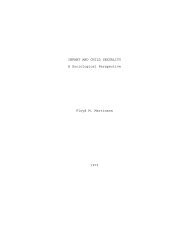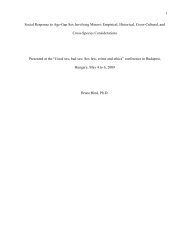Download PDF - Springer
Download PDF - Springer
Download PDF - Springer
You also want an ePaper? Increase the reach of your titles
YUMPU automatically turns print PDFs into web optimized ePapers that Google loves.
Biological Definitions of Pedophilia 335<br />
using children from 3 to 5 years of age. The U. S. Humane Society estimated<br />
that 1.2 million children annually are involved in illegal commercial enterprises<br />
revolving around sexual exploitation. Another 100,000 children are<br />
estimated to be sexually abused annually by individuals (Kemp, 1980).<br />
Adult sexual interest in children is not confined to the Western world.<br />
Ritualized homosexuality involving young boys is practiced in 10 to 20% of<br />
Melanesian societies (Herdt, 1984). Variations of the manner in which sex<br />
is allowed are found from one tribe to another with some using fellatio, others<br />
anal intercourse, and still others masturbation. In these societies, girls as<br />
young as 8 years old are also used for special ceremonies that involve making<br />
medicine from seminal fluids gathered from the child after intercourse. Young<br />
brides of the Kimam Papuan tribe are "tested" by many men prior to the wedding<br />
ceremony to insure their fitness for marriage (Serpenti, 1984).<br />
The historical and cross-cultural record clearly reflects the long-standing<br />
existence of the use of children in sexual practices. The accounts given thus<br />
far have all centered on extrafamilial liaisons. Evidence indicates that intrafamilial<br />
adult/child sex has an equally pervasive history.<br />
HISTORICAL AND CROSS-CULTURAL PERSPECTIVES ON INCEST<br />
The factor of relatedness has resulted in a different conceptualization<br />
of adult/child sex when the act occurs between a child and a relative. The<br />
ubiquity of the incest taboo has been debated by sociologists and anthropologists.<br />
Sociologists have generally contended that the prohibition against incest<br />
is societally determined and is not universal (Solomon, 1978), while anthropologists<br />
have generally contended that the incest taboo is one of the most universal<br />
of all rules (Fox, 1972). Whether universal or just extremdy widespread,<br />
the prevalence of the incest taboo indicates a common cross-cultural process<br />
that has led to its adoption in varying degrees in divergent cultures.<br />
In spite of the debate over how and why the incest taboo came about,<br />
empirical evidence is convincing that intrafamily mating lead to a selective<br />
disadvantage (Lindzey, 1967). In Middle Eastern societies, where relatives<br />
frequently married, increased rates of genetic disease have been found (Feldman,<br />
1980). Also in Japan, where as many as 5% of all marriages were between<br />
first cousins, Schull and Neel (1965) found that inbred offspring were<br />
not as healthy as ontbred offspring. Evidence from the United States is similar;<br />
children of incestuous matings display inordinately high rates of mental<br />
retardation and physical anomalies (Adams and Neel, 1967).<br />
Some form of the incest taboo appears to be in place not only cross-culturally<br />
but also across species. Among primates, where paternity is often in
















